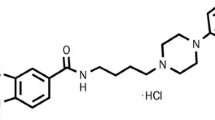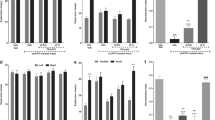Abstract
Rationale
Quetiapine, an atypical neuroleptic, has beneficial antipsychotic effects in schizophrenic patients, but with a lower incidence of extrapyramidal symptoms (EPS) compared with typical antipsychotics. While typical antipsychotics are often switched to atypical agents when adverse effects become limiting, there is little preclinical information to support this strategy, both in terms of efficacy and side effects.
Objectives
The antipsychotic effects and EPS during concomitant administration of quetiapine with haloperidol, a typical antipsychotic agent, were evaluated in mice and compared with chlorpromazine and risperidone.
Methods
We first investigated the antipsychotic effects and EPS liability of quetiapine, risperidone, chlorpromazine, and haloperidol when administered alone to select optimal doses for subsequent combination studies. The second study was designed to evaluate the antipsychotic efficacy and EPS profile of concomitant administration of quetiapine, risperidone, or chlorpromazine with haloperidol. Antipsychotic effects were evaluated with the methamphetamine-induced hyperlocomotion test, and EPS liability was evaluated in a catalepsy-induction model.
Results
Quetiapine, risperidone, chlorpromazine, and haloperidol dose-dependently reduced methamphetamine-induced hyperlocomotion, with ED50 values of 5.6, 0.020, 1.8, 0.035 mg/kg, respectively. In the catalepsy test, quetiapine only weakly induced catalepsy at the highest dose of 100 mg/kg, whereas risperidone, chlorpromazine, and haloperidol dose-dependently induced catalepsy with ED50 values of 0.25, 4.6, and 0.10 mg/kg, respectively. While the combination of quetiapine (6 mg/kg) and haloperidol (0.04 mg/kg) significantly reduced methamphetamine-induced hyperlocomotion in comparison with haloperidol alone, quetiapine (10, 32 mg/kg) plus haloperidol did not potentiate the cataleptogenic activity of haloperidol. In contrast, risperidone (0.1, 0.32 mg/kg) or chlorpromazine (3.2 mg/kg) significantly augmented catalepsy induced by haloperidol. Catalepsy induced by co-administration of quetiapine (10 mg/kg) and haloperidol (0.1 mg/kg) was significantly potentiated by WAY100635, a 5-HT1A antagonist, and catalepsy induced by co-administration of risperidone (0.1 mg/kg) and haloperidol (0.1 mg/kg) was significantly antagonized by 8-OH-DPAT, a 5-HT1A agonist.
Conclusion
The present study demonstrated that the combined administration of quetiapine with haloperidol did not aggravate EPS, possibly because of its affinity for 5-HT1A receptors. This finding may have the clinical implication that quetiapine could provide a successful regimen in switching from typical antipsychotic agents in the symptom management of schizophrenia, or even in adjunctive therapy with other antipsychotic agents.






Similar content being viewed by others
References
Ahlqvist J, Isacson R, Wahlestedt C, Salmi P (2003) Anti-cataleptic effects of clozapine, but not olanzapine and quetiapine, on SCH 23390- or raclopride-induced catalepsy in rats. Eur Neuropsychopharmacol 13:177–182
Arvanitis LA, Miller BG, The Seroquel Trial 13 Study Group (1997) Multiple fixed doses of “Seroquel” (quetiapine) in patients with acute exacerbation of schizophrenia: a comparison with haloperidol and placebo. Biol Psychiatry 42:233–246
Bantick RA, Deakin JF, Grasby PM (2001) The 5-HT1A receptor in schizophrenia: a promising target for novel atypical neuroleptics? J Psychopharmacol 15:37–46
Burnet PW, Eastwood SL, Harrisson PJ (1997) [3H]WAY-100635 for 5-HT1A receptor autoradiography in human brain: a comparison with [3H]8-OH-DPAT and demonstration of increased binding in the frontal cortex in schizophrenia. Neurochem Int 30:565–574
Casey DE (1989) Clozapine: neuroleptic-induced EPS and tardive dyskinesia. Psychopharmacology 99:S47–S53
Casey DE (1999) Tardive dyskinesia and atypical antipsychotic drugs. Schizophr Res 35:S61–S66
Copolov DL, Link CGG, Kowalcyk B (2000) A multicentre, double-blind, randomized comparison of quetiapine (ICI 204,636, ‘Seroquel’) and haloperidol in schizophrenia. Psychol Med 30:95–105
Cutler AJ, Goldstein JM, Tumas JA (2002) Dosing and switching strategies for quetiapine fumarate. Clin Ther 24:209–222
De Nayer A, Windhager E, Irmansyam, Larmo I, Linderbauer B, Rittmannsberger H, Platz T, Jones AM, Whiteford JL, Altman CA, On behalf of the SPECTRUM study group (2003) Efficacy and tolerability of quetiapine in patients with schizophrenia switched from other antipsychotics. Int J Psychiatr Clin Pract 7:59–66
Fibiger HC, Miller JJ (1977) An anatomical and electrophysiological investigation of the serotonergic projection from the dorsal raphe nucleus to the substantia nigra in the rat. Neuroscience 2:975–987
Guan HJ, Dai J, Zhu XZ (2000) Atypical antipsychotic effects of quetiapine fumarate in animal models. Acta Pharmacol Sin 21:205–210
Hamner MB, Arvanitis LA, Miller BG, Link CGG, Hong WW (1996) Plasma prolactin in schizophrenia subjects treated with Seroquel (ICI204,636). Psychopharmacol Bull 32:107–110
Ichikawa J, Li Z, Dai J, Meltzer HY (2002) Atypical antipsychotic drugs, quetiapine, iloperidone, and melperone, preferentially increase dopamine and acetylcholine release in rat medial prefrontal cortex: role of 5-HT1A receptor agonism. Brain Res 956:349–357
Jibson MD, Tandon R (1998) New atypical antipsychotic medications. J Psychiatr Res 32:215–228
Kapur S, Remington G (1996) Serotonin-dopamine interaction and its relevance to schizophrenia. Am J Psychiatry 153:466–476
Kinon BJ, Basson BR, Gilmore JA, Malcolm S, Stauffer VL (2000) Strategies for switching from conventional antipsychotic drugs or risperidone to olanzapine. J Clin Psychiatry 61:833–840
Kooy DV, Hattori T (1980) Dorsal raphe cells with collateral projections to the caudate-putamen and substantia nigra: a fluorescent retrograde double labeling study in the rat. Brain Res 186:1–7
Meats P (1997) Quetiapine (‘Seroquel’); an effective and well-tolerated atypical antipsychotic. Int J Psychiatr Clin Pract 1:231–239
Meltzer HY (1992) The importance of serotonin-dopamine interactions in the action of clozapine. Br J Psychiatry 160:22–29
Meltzer HY, Daniels S, Fang VS (1975) Clozapine increases rat serum prolactin levels. Life Sci 17:339–342
Migler BM, Warawa EJ, Malick JB (1993) Seroquel: behavioral effects in conventional and novel tests for atypical antipsychotic drug. Psychopharmacology 112:299–307
Millan MJ (2000) Improving the treatment of schizophrenia: focus on serotonin (5-HT)1A receptors. J Pharmacol Exp Ther 295:853–861
Nedergaard S, Bolam JP, Greenfield SA (1988) Facilitation of a dendritic calcium conductance by 5-hydroxytryptamine in the substantia nigra. Nature 333:174–177
Newman-Tancredi A, Gavaudan S, Conte C, Chaput C, Touzard M, Verriele L, Audinot V, Millan MJ (1998) Agonist and antagonist actions of antipsychotic agents at 5-HT1A receptors: a [35S]GTPγS binding study. Eur J Pharmacol 355:245–256
Olpe HR, Koella WP (1977) The response of striatal cells upon stimulation of the dorsal and median raphe nuclei. Brain Res 122:357–360
Peuskens J, Link CGG (1997) A comparison of quetiapine and chlorpromazine in the treatment of schizophrenia. Acta Psychiatr Scand 96:265–273
Purdon SE, Malla A, Labelle A, Lit W (2001) Neuropsychological change in patients with schizophrenia after treatment with quetiapine or haloperidol. J Psychiatry Neurosci 26:137–149
Richelson E, Souder T (2000) Binding of antipsychotic drugs to human brain receptors. Focus on newer generation compounds. Life Sci 68:29–39
Saller CF, Salama AI (1993) Seroquel: biochemical profile of a potential atypical antipsychotic. Psychopharmacology 112:285–292
Velligan DI, Newcomer J, Pultz J, Csernansky J, Hoff AL, Mahurin R, Miller AL (2002) Does cognitive function improve with quetiapine in comparison to haloperidol? Schizophr Res 53:239–248
Weiden PJ, Aquila R, Dalheim L, Standard JM (1997) Switching antipsychotic medications. J Clin Psychiatry 58:63–72
Weiss JM, Kilts CD (1995) Animal models of depression and schizophrenia. In: Schatzberg AF, Nemeroff CB (eds) Textbook of psychopharmacology. American Psychiatric Association, USA, pp 81–123
Acknowledgements
The authors would like to thank Drs. Raymond D. Price (Fujisawa Pharmaceutical Co. Ltd) and Rod Sayce (AstraZeneca) for their helpful comments in preparing the manuscript.
Author information
Authors and Affiliations
Corresponding author
Rights and permissions
About this article
Cite this article
Tada, M., Shirakawa, K., Matsuoka, N. et al. Combined treatment of quetiapine with haloperidol in animal models of antipsychotic effect and extrapyramidal side effects: comparison with risperidone and chlorpromazine. Psychopharmacology 176, 94–100 (2004). https://doi.org/10.1007/s00213-004-1866-y
Received:
Accepted:
Published:
Issue Date:
DOI: https://doi.org/10.1007/s00213-004-1866-y




